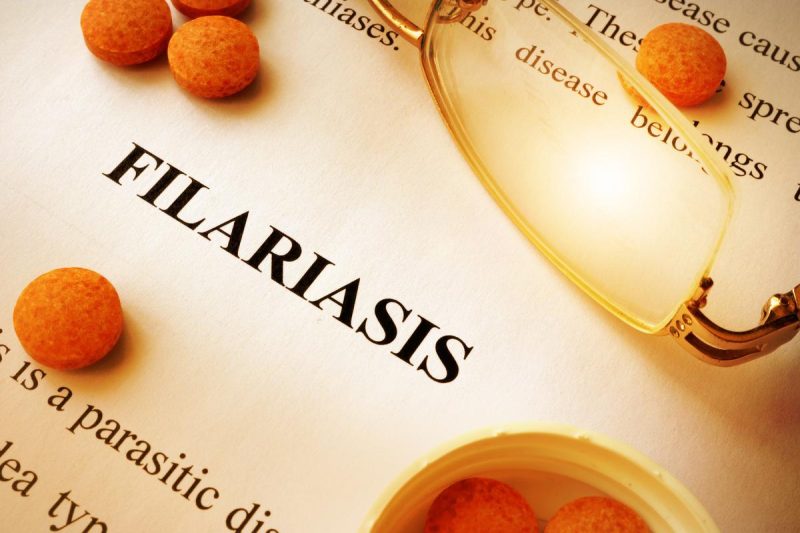Filariasis is an infectious disease transmitted through mosquito bites. While some individuals may not exhibit symptoms, others might experience inflammation, swelling, or fever.
In more severe cases, filariasis can lead to conditions like lymphedema (fluid retention) or hydrocele (swelling in the scrotum).
To prevent filariasis, it is essential to avoid mosquito bites, primarily if you reside in or travel to tropical climates.
In its most extreme form, filariasis can cause disfigurement, such as thickening of the skin and swelling in the calves, which has led to the term “elephantiasis” being used to describe the condition.
Filariasis is caused by tiny parasitic worms known as filarial worms, which infect the lymphatic system. The lymphatic system maintains fluid balance and protects the body against infections.
Consequently, healthcare professionals often refer to this condition as lymphatic filariasis due to its impact on the lymphatic system.
Who might get filariasis?
Filariasis primarily occurs in tropical climates, with a higher prevalence of infection reported in countries across Asia, Africa, and South America.
However, cases of filariasis are relatively rare in North America, as the worms responsible for the disease are not found in the United States.
The risk of contracting filariasis during a short visit to one of these high-risk countries is low.
However, individuals who reside in or spend extended periods in these areas are more susceptible to getting infected with filariasis, especially if they stay for months or years.
Symptoms and causes
Filariasis is caused by a parasitic infection involving tiny, thread-like filarial worms. These worms are invisible to the naked eye and invade the human body.
Different types of filarial worms are responsible for the infection, including Wuchereria bancrofti, which accounts for approximately 9 out of 10 cases, Brugia malayi, and Brugia timori.
Lymphatic filariasis, a common disease, may not always exhibit severe symptoms in about two-thirds of infected individuals. However, it can weaken the immune system, leading to various complications.
Some of the symptoms experienced by those with lymphatic filariasis include inflammation, lymphedema (fluid buildup in the lymphatic system), hydrocele (swelling in the scrotum), and edema (swelling in the arms, legs, breasts, and female genitals).
The infection’s long-term effects can damage the lymphatic system, making it challenging for the body to fight infections effectively. Its weakened immune response can result in frequent bacterial infections.
Additionally, filariasis can lead to elephantiasis, characterized by thickened and hardened skin, fluid retention, and painful, swollen, and enlarged body parts. Filariasis may cause Tropical Pulmonary Eosinophilia Syndrome, in which white blood cells increase and cause coughing and difficulty breathing, among other symptoms.
Filariasis spreads through mosquito bites. When a mosquito bites an infected person, the filarial worms present in their blood get transmitted to the mosquito. Then, when this infected mosquito bites another person, the worms enter their bloodstream, travel to the lymphatic system, and mature into adult worms.
These adult worms can remain alive for up to seven years and reproduce, releasing millions of worms into the person’s bloodstream.
Diagnosis and tests
Diagnosing filariasis, particularly lymphatic filariasis, requires a thorough examination of a blood sample. Healthcare providers utilize two main methods for diagnosis:
Microscopic Testing
By analyzing your blood sample under a microscope, providers can detect the presence of filarial worms. These worms exhibit nocturnal periodicity, meaning they are most active in the blood during nighttime. As a result, blood samples for this test are typically taken at night.
Antibody Testing
Providers measure antibodies in your blood sample in this method. Antibodies are produced when exposed to an infection. Unlike microscopic testing, the antibody test can be conducted during the day.
Both of these diagnostic approaches are essential for accurately identifying and confirming cases of filariasis in patients.
Management and treatment
The treatment approach for filariasis is tailored based on the specific symptoms and their severity. Generally, filariasis treatment may involve:
Medication
Antiparasitic medicines such as ivermectin (Stromectol(r)), diethylcarbamazine (Hetrazan(r), or albendazole (Albenza(r) are often prescribed. These medicines target and eliminate adult worms in the blood or prevent their reproduction.
Taking these medications can also control the transmission of the infection to others. As the worms may still reside in the body, these drugs are typically taken once a year for several weeks.
Surgery
In some cases, surgery may be necessary to remove dead worms from the bloodstream. Additionally, if filariasis has led to hydrocele, surgical intervention may be performed to alleviate the fluid accumulation in the scrotum.
Elephantiasis Treatment
Healthcare providers may recommend various strategies to control swelling, such as elevation techniques or wearing compression garments.
While undergoing filariasis treatment, it’s essential to be closely monitored by a healthcare professional due to the possibility of severe side effects associated with anti-parasitic medications, including dizziness, fever, headache, muscle or joint pain, and nausea.
To prevent the worsening of lymphedema, individuals can implement various self-care measures, such as disinfecting and covering wounds, elevating swollen limbs, exercising to improve lymphatic fluid flow, and maintaining proper hygiene by washing and drying swollen areas daily. Wearing well-fitted shoes is also recommended to reduce the risk of falling and potential injuries.
Although there is currently no vaccine or cure for filariasis, appropriate medication can effectively eliminate many of the worms and prevent further transmission of the infection. Treatment can also alleviate filariasis symptoms, providing relief and improving the individual’s quality of life.
Prevention
Preventing filariasis is crucial, especially in tropical regions where mosquito bites can lead to infection. To safeguard against filariasis, consider the following measures if you reside in or travel to areas where the disease is prevalent:
- Sleep under a mosquito net to create a protective barrier against mosquito bites, especially during the night when mosquitoes are most active.
- Apply insect repellent to exposed skin, particularly in the evening when mosquito activity increases.
- Wear long pants and sleeves to minimize exposed skin areas mosquitoes can bite.
The World Health Organization recommends a preventive chemotherapy approach in regions with widespread filariasis. As part of this strategy, individuals at risk of infection receive an annual dosage of specific chemotherapy medications.
While these medications may have a limited effect on adult worms, they can impede the reproduction of younger worms and prevent parasites from spreading to mosquitoes.
This proactive measure can significantly reduce the risk of filariasis infection and its subsequent transmission.
Outlook/ prognosis
Do the effects of lymphatic filariasis persist in the long term?
Lymphatic filariasis can lead to chronic conditions like lymphedema or elephantiasis, which have no definitive cure. However, it is possible to manage these conditions and alleviate symptoms effectively.
Individuals living with these chronic conditions may face adverse social consequences. Severe and apparent symptoms, such as extreme swelling, can result in social stigma.
Additionally, chronic swelling or pain might hinder a person’s ability to work, impacting their livelihood.
Despite these challenges, proper management and support can enhance the quality of life for those affected by lymphatic filariasis.
Conclusion
Lymphatic filariasis is a parasitic infection prevalent in tropical climates but rare in North America. It spreads through the bites of infected mosquitoes, which transmit tiny worms into your bloodstream and lymphatic system.
While some individuals may not display visible symptoms, others may experience chronic inflammation and swelling.
An annual medication can help reduce the worm burden in the bloodstream and alleviate symptoms. Preventing infection requires taking precautions to avoid mosquito bites.






